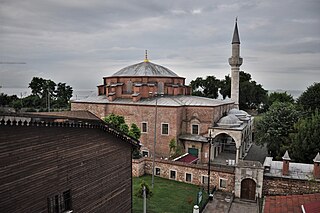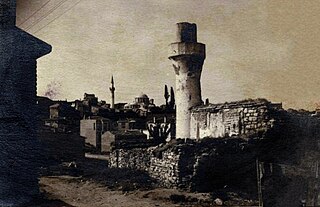External links
![]() Media related to Istanbul at Wikimedia Commons
Media related to Istanbul at Wikimedia Commons
This list of museums and monuments in Istanbul, Turkey, includes the relevant architectural entities within Istanbul's city limits.
(in alphabetical order; Turkish-language name in parentheses where appropriate)
![]() Media related to Istanbul at Wikimedia Commons
Media related to Istanbul at Wikimedia Commons

Hagia Sophia, officially the Hagia Sophia Grand Mosque, is a converted former church and mosque and a major cultural and historical site in Istanbul, Turkey. The last of three church buildings to be successively erected on the site by the Eastern Roman Empire, it was completed in 537 AD. The site was an Eastern Orthodox church from 360 AD to 1204, when it was converted to a Catholic church following the Fourth Crusade. It was reclaimed in 1261 and remained Eastern Orthodox until the Ottoman conquest of Constantinople in 1453. It served as a mosque until 1935, when it became a museum. In 2020, the site once again became a mosque.

Byzantine architecture is the architecture of the Byzantine Empire, or Eastern Roman Empire, usually dated from 330 AD, when Constantine the Great established a new Roman capital in Byzantium, which became Constantinople, until the fall of the Byzantine Empire in 1453. There was initially no hard line between the Byzantine and Roman Empires, and early Byzantine architecture is stylistically and structurally indistinguishable from late Roman architecture. The style continued to be based on arches, vaults and domes, often on a large scale. Wall mosaics with gold backgrounds became standard for the grandest buildings, with frescos a cheaper alternative.

Galata is the former name of the Karaköy neighbourhood in Istanbul, which is located at the northern shore of the Golden Horn. The district is connected to the historic Fatih district by several bridges that cross the Golden Horn, most notably the Galata Bridge. The medieval citadel of Galata was a colony of the Republic of Genoa between 1273 and 1453. The famous Galata Tower was built by the Genoese in 1348 at the northernmost and highest point of the citadel. Galata is now a quarter within the district of Beyoğlu in Istanbul.

Fatih is a municipality and district of Istanbul Province, Turkey. Its area is 15 km2, and its population is 368,227 (2022). It is home to almost all of the provincial authorities but not the courthouse. It encompasses the historical peninsula, coinciding with old Constantinople. In 2009, the district of Eminönü, which had been a separate municipality located at the tip of the peninsula, was once again remerged into Fatih because of its small population. Fatih is bordered by the Golden Horn to the north and the Sea of Marmara to the south, while the Western border is demarked by the Theodosian wall and the east by the Bosphorus Strait.

Following the proclamation of the Republic, Turkish museums developed considerably, mainly due to the importance Atatürk had attached to the research and exhibition of artifacts of Anatolia. When the Republic of Turkey was proclaimed, there were only the İstanbul Archaeology Museum called the "Asar-ı Atika Müzesi", the Istanbul Military Museum housed in the St. Irene Church, the Islamic Museum in the Suleymaniye Complex in Istanbul and the smaller museums of the Ottoman Empire Museum in a few large cities of Anatolia.

The Chora Church or Kariye Mosque is a medieval Greek Orthodox church building, mostly used as a mosque since the 16th century, in the Edirnekapı neighborhood of Istanbul, Turkey. It is mainly famous for its outstanding Late Byzantine mosaics and frescos.

The conversion of non-Islamic places of worship into mosques occurred during the life of Muhammad and continued during subsequent Islamic conquests and under historical Muslim rule. Hindu temples, Jain Temples, Christian churches, synagogues, and Zoroastrian fire temples have been converted into mosques.

The Little Hagia Sophia mosque, formerly the Church of Saints Sergius and Bacchus, is a former Greek Orthodox church dedicated to Saints Sergius and Bacchus in Constantinople, built between 532 and 536, and converted into a mosque during the Ottoman Empire.

Zeyrek Mosque or the Monastery of the Pantokrator, is a large mosque in Fazilet Sokağı in the Zeyrek district of Fatih in Istanbul, overlooking the Golden Horn. It is made up of two former Byzantine churches and a chapel joined together and represents the best example of Middle Byzantine architecture in Constantinople. After Hagia Sophia, it is the largest Byzantine religious edifice still standing in Istanbul.

The Pammakaristos Church, also known as the Church of Theotokos Pammakaristos, is one of the most famous Byzantine churches in Istanbul, Turkey, and was the last pre-Ottoman building to house the Ecumenical Patriarchate. Converted in 1591 into the Fethiye Mosque, it is today partly a museum housed in a side chapel or parekklesion. One of the most important examples of Constantinople's Palaiologan architecture, the church contains the largest quantity of Byzantine mosaics in Istanbul after the Hagia Sophia and The Chora.

Hirami Ahmet Pasha Mosque is a former Eastern Orthodox church converted into a mosque by the Ottomans. The small church, one among the 36 dedicated to Saint John the Baptist in Constantinople, was part of a monastery bearing the same name. Its full name was Saint John the Forerunner by-the-Dome. It is the smallest Byzantine church of Constantinople still extant and has never been studied.

Atik Mustafa Pasha Mosque is a former Eastern Orthodox church in Istanbul, converted into a mosque by the Ottomans. In Çember Sokak in the neighbourhood of Ayvansaray, in the district of Fatih, Istanbul, it lies just inside the walled city at a short distance from the Golden Horn, at the foot of the sixth hill of Constantinople.

The architecture of Istanbul describes a large mixture of structures which reflect the many influences that have made an indelible mark in all districts of the city. The ancient part of the city is still partially surrounded by the Walls of Constantinople, erected in the 5th century by Emperor Theodosius II to protect the city from invasion. The architecture inside the city proper contains buildings and structures which came from Byzantine, Genoese, Ottoman, and modern Turkish sources. The city has many architecturally significant entities. Throughout its long history, Istanbul has acquired a reputation for being a cultural and ethnic melting pot. As a result, there are many historical mosques, churches, synagogues, palaces, castles and towers to visit in the city.

The Odalar Mosque was an Ottoman mosque in Istanbul. The building was originally a Byzantine-era Eastern Orthodox church of unknown dedication. In 1475, after the Fall of Constantinople (1453), it became a Roman Catholic church, dedicated to Saint Mary of Constantinople, until finally it was converted into a mosque by the Ottomans in 1640. The mosque was destroyed by fire in 1919, and since then has fallen into ruin. As of 2011, only some walls remain, hidden among modern buildings.
Toklu Dede Mosque, was an Ottoman mosque in Istanbul, Turkey. The building was originally a Byzantine Eastern Orthodox church of unknown dedication. It was almost completely destroyed in 1929.
The following is a timeline of the history of the town of Istanbul, Turkey.

The following outline is provided as an overview of and topical guide to Istanbul: